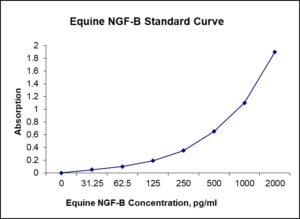Nori Equine NGF-B ELISA Kit
$461.00 – $832.00
This ELISA kit is for quantification of NGF-B in horse. This is a quick ELISA assay that reduces time to 50% compared to the conventional method, and the entire assay only takes 3 hours. This assay employs the quantitative sandwich enzyme immunoassay technique and uses biotin-streptavidin chemistry to improve the performance of the assays. An antibody specific for NGF-B has been pre-coated onto a microplate. Standards and samples are pipetted into the wells and any NGF-B present is bound by the immobilized antibody. After washing away any unbound substances, a detection antibody specific for NGF-B is added to the wells. Following wash to remove any unbound antibody reagent, a detection reagent is added. After intensive wash a substrate solution is added to the wells and color develops in proportion to the amount of NGF-B bound in the initial step. The color development is stopped, and the intensity of the color is measured.
Alternative names for NGF-B: Nerve growth factor beta, NGFB
This product is for laboratory research use only not for diagnostic and therapeutic purposes or any other purposes.
- Description
- How Elisa Works
- Product Citation ()
- Reviews (0)
Description
Nori Equine NGF-B ELISA Kit Summary
Alternative names for NGF-B: Nerve growth factor beta
Alternative name for equine: Horse
| Assay Type | Solid Phase Sandwich ELISA |
| Format | 96-well Microplate or 96-Well Strip Microplate |
| Method of Detection | Colorimetric |
| Number of Targets Detected | 1 |
| Target Antigen Accession Number | Q9N1V4 |
| Assay Length | 3 hours |
| Quantitative/Semiquantitative | Quantitative |
| Sample Type | Plasma, Serum, Cell Culture, Urine, Cell/Tissue Lysates, Synovial Fluid, BAL, |
| Recommended Sample Dilution (Plasma/Serum) | No dilution for sample <ULOQ; sufficient dilution for samples >ULOQ |
| Sensitivity | 6 pg/mL |
| Detection Range | 31.25-2000 pg/mL |
| Specificity | Equine NGF-B |
| Cross-Reactivity | < 0.5% cross-reactivity observed with available related molecules, < 50% cross-species reactivity observed with species tested. |
| Interference | No significant interference observed with available related molecules |
| Storage/Stability | 4 ºC for up to 6 months |
| Usage | For Laboratory Research Use Only. Not for diagnostic or therapeutic use. |
| Additional Notes | The kit allows for use in multiple experiments. |
Standard Curve
Kit Components
1. Pre-coated 96-well Microplate
2. Biotinylated Detection Antibody
3. Streptavidin-HRP Conjugate
4. Lyophilized Standards
5. TMB One-Step Substrate
6. Stop Solution
7. 20 x PBS
8. Assay Buffer
Other Materials Required but not Provided:
1. Microplate Reader capable of measuring absorption at 450 nm
2. Log-log graph paper or computer and software for ELISA data analysis
3. Precision pipettes (1-1000 µl)
4. Multi-channel pipettes (300 µl)
5. Distilled or deionized water
Protocol Outline
1. Prepare all reagents, samples and standards as instructed in the datasheet.
2. Add 100 µl of Standard or samples to each well and incubate 1 h at RT.
3. Add 100 µl of Working Detection Antibody to each well and incubate 1 h at RT.
4. Add 100 µl of Working Streptavidin-HRP to each well and incubate 20 min at RT.
5. Add 100 µl of Substrate to each well and incubate 5-30 min at RT.
6. Add 50 µl of Stop Solution to each well and read at 450 nm immediately.
Background:
Nerve growth factor (NGF) is a neurotrophic factor and neuropeptide primarily involved in the regulation of growth, maintenance, proliferation, and survival of certain target neurons. NGF also plays crucial roles in the survival of pancreatic beta cells and the regulation of the immune system. NGF is produced as proNGF in a 7S, 130-kDa complex of 3 proteins – Alpha-NGF, Beta-NGF (NGF-B), and Gamma-NGF (2:1:2 ratio) when expressed. The gamma subunit of this complex acts as a serine protease and cleaves the N-terminal of the beta subunit into functional NGF (NGF-B). The term NGF usually refers to the 2.5S, 26-kDa beta subunit of the protein, the only component of the 7S NGF complex that is biologically active. NGF binds with at least two classes of receptors: TrkA and LNGFR/p75NTR. [1][2] NGF can promote bcl-2 gene expression by binding to the TrkA, which stimulates the proliferation and survival of the target neuron. High affinity binding between proNGF, sortilin, and p75NTR can result in either survival or programmed cell death (PCD). Studies show that superior cervical ganglia neurons that express both p75NTR and TrkA die when treated with proNGF,[1]while NGF treatment of these same neurons results in survival and axonal growth. Survival and PCD mechanisms are mediated through adaptor protein binding to the death domain of the p75NTR cytoplasmic tail. NGF expression may be stimulated by DHEA[3] and ACTH. The expression of NGF is increased in inflammatory diseases where it suppresses inflammation.[4] NGF appears to promote myelin repair. NGF is involved in various psychiatric disorders. Dysregulation of NGF signaling has also been linked to Alzheimer’s disease.[5] NGF has been shown to play a role in cardiovascular diseases.[6] Reduced plasma levels of NGF and BDNF have been associated with acute coronary syndromes and metabolic syndromes.[7]
References
- Lee R, et al. (Nov 2001). Science. 294(5548): 1945–8.
- Nykjaer A, et al. (2004). Nature. 427(6977): 843–8.
- Rahmani A, et al. (2011). Advances in Pharmacological Sciences. 2013: 506191.
- Freund V, Frossard N (2004). Progress in Brain Research. 146: 335–46.
- Counts SE, et al. (2005). J Neuropathology and Experimental Neurology. 64(4): 263–72.
- Chaldakov GN, et al. (2004). Progress in Brain Research. 146: 279–89.
- Manni L, et al. 2005). International Journal of Cardiology. 102(1): 169–71.
Be the first to review “Nori Equine NGF-B ELISA Kit”
You must be logged in to post a review.




























Reviews
There are no reviews yet.